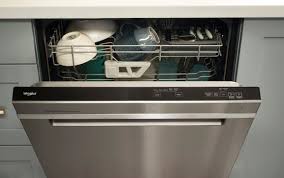
Most households today rely on a dishwasher to save time, water, and hassle. So when the appliance suddenly won’t start a cycle, it can throw your kitchen routine into chaos. If you’re staring at a dishwasher that just won’t budge—don’t panic. In many cases, the issue is something simple you can fix yourself.
Here’s a step-by-step breakdown of what might be causing your dishwasher to stay silent—and what to do next.
Step 1: Make Sure the Basics Are Covered
Before jumping to conclusions, always check the obvious first.

- Is the unit plugged in properly?
- Try another device in the same outlet to test it.
- Check the circuit breaker—dishwashers are often on their own fuse.

Make sure the water valve is fully open. If the machine can’t get water, it may not even attempt to start the cycle.

Sometimes the power button can wear out or feel loose. Press it again and check for any signs of life—lights, beeps, or motor sounds.
Step 2: Confirm the Door Is Fully Latched
A dishwasher won’t start unless the door is closed and latched securely. Many modern models use a door sensor that prevents the program from running unless the latch clicks into place.
- Look for debris or misalignment around the door seal.
- If the latch feels soft or loose, it might need replacement.
- Some models will show an error light if the door isn’t sealed properly.
Step 3: Take a Look Inside
If everything seems fine from the outside, open up the dishwasher and inspect the interior.

If water is standing in the tub, the issue could be a clogged filter or drain hose.
- Remove and clean the bottom filter basket.
- Detach the drain hose (if you’re comfortable doing so) and flush it out.
If your dishwasher has a removable bottom tray, check for any leaks, signs of flooding, or error codes that might explain the stoppage.
Step 4: Check for Dish Obstruction
Sometimes it’s not the machine—it’s how the dishes were loaded.
- Ensure the top spray arm can spin freely.
- Avoid placing tall items that block moving parts.
- Check for signs of a jammed detergent dispenser or rinse aid error.
Some dishwashers won’t start if they detect internal blockages. Double-check placement and reload the machine.
Step 5: Test for Pump or Water Pressure Issues
A dishwasher relies on both a circulation pump and a drain pump to run properly. If either one is stuck or blocked, the appliance may refuse to start.
- You may hear a soft humming or clicking, then silence—this could signal pump trouble.
- If you’re comfortable with DIY, inspect the area under the appliance for signs of damage or leaks.
- In older homes, low water pressure can also cause start failures.
For newer models or more complex internal parts, calling a certified technician is usually the best bet. If you’re nearby, dishwasher repair services can usually get things moving again the same day.
Step 6: Still Not Starting? It’s Time for Professional Help
If you’ve walked through all the basic checks and your dishwasher is still refusing to run, it’s time to call in a professional. Common repairs include:
- Replacing a faulty control board
- Fixing broken latch mechanisms
- Clearing hidden blockages inside the plumbing system
- Replacing failed pumps or water inlet valves
An expert from Top Appliance Repair will be able to test components quickly and safely—and often complete repairs without needing to remove the appliance.
Bonus Tip: Pay Attention to Long-Term Issues
If your dishwasher fails to start regularly, but seems to work after being reset or unplugged, it could be a sign of a bigger electrical or control issue. Don’t ignore it—recurring problems usually get worse with time.
If you’re thinking of buying a new home or preparing your current one for sale, don’t forget the importance of functioning appliances. Homes listed through Tooyn Homes often feature professionally maintained kitchens that are ready to use from day one—no unexpected surprises.







